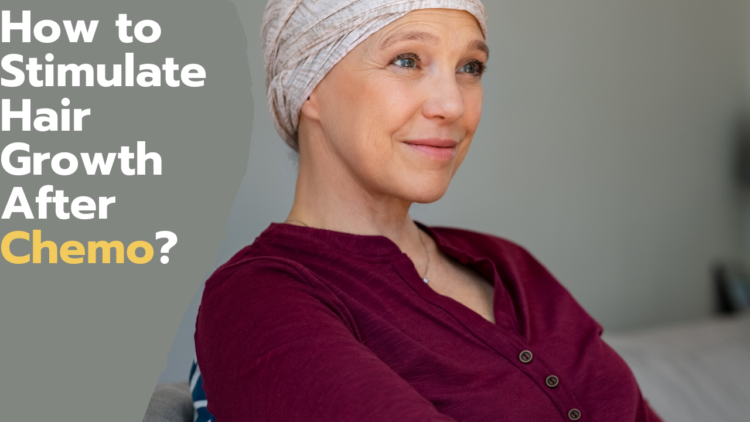As if having cancer wasn’t bad enough in and of itself, having it treated with chemotherapy comes with its own set of challenges. The side effects can be debilitating and include nausea, vomiting, diarrhea, loss of appetite, fatigue, fever, mouth sores, pain, constipation, and easy bruising. On top of all those, you’ll probably lose all your hair as well, which can be the most psychologically difficult one of all. The reason for this is that chemotherapy kills the cancer cells, but it also does a good deal of damage to healthy cells as well, including your hair follicles. If you’re in this situation, you’re probably very interested in finding out how to stimulate hair growth after chemo. That will be the focus of this article.
Hair Growth Timetable
If you don’t do anything after your treatment ends, you should begin to have a soft fuzz appearing with two or three weeks. A month after completing treatment, real hair should start to grow at its normal rate. This varies from person to person, but generally speaking, hair growing from your scalp tends to grow at a rate of about .3 to .4 mm/day, which translates into about 6 inches (15.24 cm) per year, or half an inch per month. On that schedule, two months after treatment you ought to have about an inch of real hair.
The Importance of Overall Health
In terms of getting back a health head of full hair, the most important thing you can do is keep yourself as health as possible. As noted in previous articles, this includes paying attention to hydration (drinking 8 glasses of water each day, 8 ounces each), getting plenty of aerobic and strength exercise each week, and maintaining a well-balanced, nutritional diet.
Nutrition for Healthy Hair
In terms of a really hair-supportive diet, you want to focus on making sure you get enough iron, protein, biotin and zinc in your diet. Your top 10 hair-growing foods that are the healthiest sources for those nutrients include the following: Salmon (rich in protein, omega-3 fatty acids and vitamin D), walnuts (rich in protein, omega-3 fatty acids and vitamin E), oysters (rich in both zinc and protein), sweet potatoes (rich in beta carotene that is turned into vitamin A), eggs (rich in zinc, selenium, sulfur and iron), spinach (rich in iron, beta carotene, folate and vitamin C), lentils (rich in protein, iron, zinc and biotin), Greek yogurt (rich in protein, vitamin B5 and vitamin D), blueberries (rich in vitamin C and antioxidants), and poultry (rich in protein, zinc, iron and B vitamins). Most importantly, remember that there are foods that actually serve to fuel the growth of cancer cells, including getting too much protein from soy, and foods with lots of added sugars. Basically, you want to strictly avoid anything that fall under the umbrella of “junk food.” Your hair, and the rest of your body, will thank you!
Additional Strategies for Hair Growth
You want to treat your newly developing hair very gently. Dyeing it, straightening it or curling it can cause damage that makes your hair grow back more slowly that you want, so avoid those. You may find that your hair grows back substantially different than it was before, such as more curly. It’s only natural that you might want to get your old look back, but avoid any rough heat treatments until your has come back all the way to make sure it’s as strong as it can be before you start making changes.
Consider Minoxidil
You can also consider a special treatment for your hair such as Minoxidil, which is sold under such brand names as Rogaine, Avacor and Regaine. The Food and Drug Administration has approved minoxidil as a hair-growth treatment, and the Mayo Clinic also endorses its use among those undergoing chemotherapy treatment for cancer. Interestingly enough, this medicine was first developed to treat high blood pressure as was administered in pill form. An unfortunate side effect was excessive hair growth. This prompted scientists to come up with a topical form of treatment specifically for hair growth. What it actually does is enlarge small arteries in the body, increasing blood flow, which is essential to supply hair with what nourishes it. It also widens hair follicles, which allows for a thicker strand of hair, and lengthens the important anagen growth phase of hair. Minoxidil can increase hair density by as much as 10-12%.
Scalp Hypothermia
This one needs more research, and it’s one that you would use during your chemotherapy treatments rather than after. The idea is that by applying cold packs to the scalp during chemotherapy, you reduce the flow of blood and decrease the amount of damaging chemotherapy drugs that destroy your hair follicles. However, if there is or might be cancer cells in your scalp, then you’re also reducing the effectiveness of the chemotherapy to kill all the cancer cells in your body.
Perhaps the thing you will need most when it comes to growing your hair back after cancer treatments is a healthy dose of patience. Growing hair takes time, and there’s no magic treatment that will get your hair back in a short amount of time. If you want to know how to stimulate hair growth after chemo, the tips and strategies I’ve provided in this article will have you well on your way to the full head of hair you enjoyed before your chemotherapy treatments.


